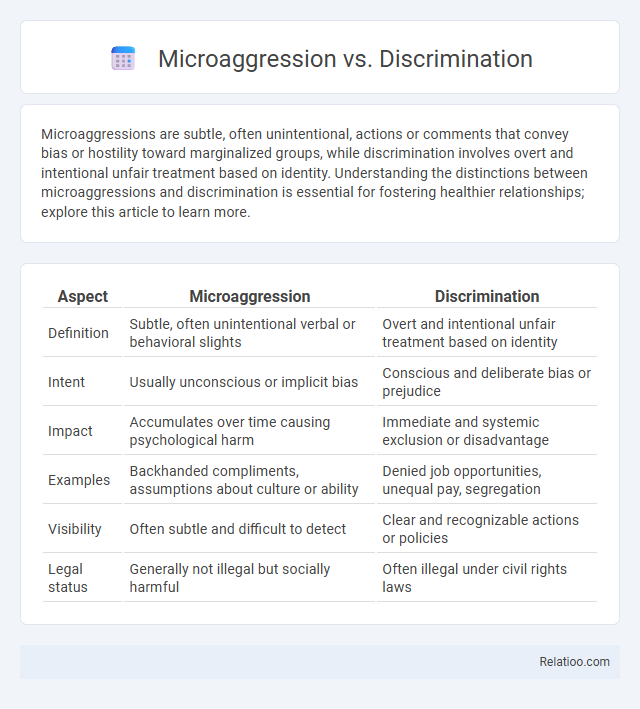Microaggressions are subtle, often unintentional, actions or comments that convey bias or hostility toward marginalized groups, while discrimination involves overt and intentional unfair treatment based on identity. Understanding the distinctions between microaggressions and discrimination is essential for fostering healthier relationships; explore this article to learn more.
Table of Comparison
| Aspect | Microaggression | Discrimination |
|---|---|---|
| Definition | Subtle, often unintentional verbal or behavioral slights | Overt and intentional unfair treatment based on identity |
| Intent | Usually unconscious or implicit bias | Conscious and deliberate bias or prejudice |
| Impact | Accumulates over time causing psychological harm | Immediate and systemic exclusion or disadvantage |
| Examples | Backhanded compliments, assumptions about culture or ability | Denied job opportunities, unequal pay, segregation |
| Visibility | Often subtle and difficult to detect | Clear and recognizable actions or policies |
| Legal status | Generally not illegal but socially harmful | Often illegal under civil rights laws |
Understanding Microaggressions: Definition and Examples
Microaggressions are subtle, often unintentional, comments or behaviors that convey negative or prejudiced messages toward marginalized groups, distinguishing them from overt discrimination, which involves clear, intentional acts of unfair treatment. Examples of microaggressions include assuming someone's capabilities based on race or making offhand remarks about cultural differences, contributing to a hostile environment without explicit hostility. Understanding microaggressions requires recognizing their cumulative impact on mental health and social inclusion, as they perpetuate systemic bias in nuanced ways.
Defining Discrimination: Key Features and Types
Discrimination involves unfair or prejudicial treatment of individuals based on characteristics such as race, gender, age, or disability, often manifesting in areas like employment, housing, and education. Key features of discrimination include intentional or systemic bias, unequal access to resources, and actions causing harm or disadvantage to protected groups. Types of discrimination encompass direct discrimination, indirect discrimination, institutional discrimination, and intersectional discrimination, each reflecting different mechanisms of exclusion and inequality.
Microaggressions vs Discrimination: Core Differences
Microaggressions are subtle, often unintentional, verbal or behavioral slights that convey negative or derogatory messages to marginalized groups, whereas discrimination involves overt, intentional actions or policies that result in unequal treatment based on race, gender, or other protected characteristics. Microaggressions frequently manifest as microinsults, microinvalidations, or microassaults, impacting mental health and perpetuating systemic bias at an interpersonal level. Discrimination operates through institutional mechanisms and legal frameworks, often leading to tangible consequences such as job denial, unequal pay, or housing exclusion, highlighting the core difference between nuanced biases and explicit prejudicial acts.
Historical Context of Microaggressions and Discrimination
Microaggressions, rooted in subtle, often unintentional verbal or behavioral slights, contrast with overt discrimination that has a long historical backdrop marked by systemic policies and social exclusion, such as Jim Crow laws and apartheid. While discrimination refers to explicit acts of unfair treatment and institutionalized inequality, microaggressions represent the pervasive undercurrents of bias that reflect and perpetuate historical power imbalances. Understanding the historical context of both reveals how microaggressions are modern manifestations of entrenched prejudices embedded in societal structures over centuries.
Common Forms of Microaggressions in Everyday Life
Common forms of microaggressions in everyday life include subtle verbal comments, nonverbal behaviors, and environmental cues that often convey implicit biases related to race, gender, or other identities. These microaggressions, such as backhanded compliments, exclusionary language, or dismissive gestures, differ from overt discrimination but cumulatively impact your mental well-being and sense of belonging. Recognizing these patterns helps address underlying prejudices that perpetuate inequality and marginalization in social and professional settings.
Systemic Discrimination: Broader Impact and Scope
Systemic discrimination encompasses widespread, institutional policies and practices that perpetuate inequality, affecting entire communities and reinforcing power imbalances. Microaggressions, subtle and often unintentional slights, contribute to the reinforcement of systemic discrimination by perpetuating stereotypes and fostering exclusion. Unlike individual acts of discrimination, systemic discrimination shapes societal structures and limits opportunities across multiple dimensions such as race, gender, and socioeconomic status.
Psychological Effects: Microaggressions and Discrimination on Mental Health
Microaggressions and discrimination both significantly impact mental health by increasing stress, anxiety, and feelings of alienation. Persistent exposure to microaggressions can lead to chronic psychological distress, manifesting as depression and lowered self-esteem, while overt discrimination often results in traumatic stress responses and long-term emotional damage. Understanding these effects is crucial for developing effective mental health interventions and promoting environments that foster psychological resilience and well-being.
Recognizing and Addressing Microaggressions
Recognizing microaggressions requires understanding subtle, often unintentional comments or actions that convey bias, which differ from overt discrimination rooted in explicit prejudice. You can address microaggressions by fostering awareness through education, encouraging open dialogue, and promoting inclusive behaviors within your environment. Implementing training programs and creating safe spaces empower individuals to identify and challenge microaggressions effectively.
Combating Discrimination: Legal and Social Approaches
Combating discrimination involves implementing legal frameworks such as anti-discrimination laws and equal employment opportunity regulations designed to protect your rights and ensure fair treatment. Social approaches include diversity training, awareness campaigns, and promoting inclusive environments to reduce microaggressions and foster understanding. Addressing both overt discrimination and subtle microaggressions creates a comprehensive strategy for equity and social justice.
Promoting Inclusive Environments: Practical Strategies
Promoting inclusive environments requires addressing microaggressions, discrimination, and overt biases by implementing clear policies, ongoing education, and open dialogue that foster respect and understanding among diverse groups. Training programs that highlight the subtle nature of microaggressions alongside the systemic impact of discrimination enhance awareness and empower individuals to intervene effectively. Creating safe spaces for feedback and continuous learning encourages accountability and supports a culture where all members feel valued and included.

Infographic: Microaggression vs Discrimination
 relatioo.com
relatioo.com